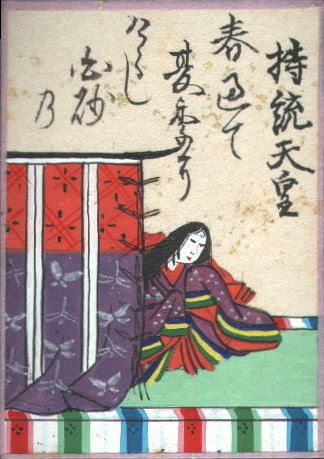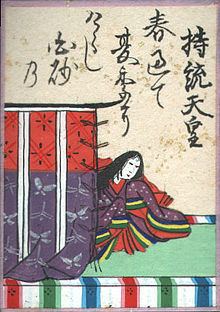Reign 686–697 Successor Mommu Role Monarch Children Prince Kusakabe | Predecessor Temmu Tenure 697–703 Name Empress Jito | |
 | ||
Burial Hinokuma-no-Ouchi no misasagi (Nara) Died December 22, 702 AD, Fujiwara-kyo Parents Emperor Tenji, Ochi-no-Iratsume Similar People | ||
Empress Jito | History of Japan 30
Empress Jitō (持統天皇, Jitō-tennō, 645 – 13 January 703) was the 41st monarch of Japan, according to the traditional order of succession.
Contents
- Empress Jito History of Japan 30
- EnglishThe Empress Who Made Japan Empress Jito
- Traditional narrative
- Events of Jits reign
- Kugy
- Non neng period
- Manysh poetry
- Hyakunin Isshu poetry
- References

Jitō's reign spanned the years from 686 through 697.
In the history of Japan, Jitō was the third of eight women to take on the role of empress regnant. The two female monarchs before Jitō were (a) Suiko and (b) Kōgyoku/Saimei. The five women sovereigns reigning after Jitō were (c) Genmei, (d) Genshō, (e) Kōken/Shōtoku, (f) Meishō, and (g) Go-Sakuramachi.
【English】The Empress Who Made Japan - Empress Jito
Traditional narrative
Empress Jitō was the daughter of Emperor Tenji. Her mother was Ochi-no-Iratsume, the daughter of Minister Ō-omi Soga no Yamada-no Ishikawa Maro. She was the wife of Emperor Tenmu, who was Tenji's half brother by another woman, and she succeeded him on the throne.
Empress Jitō's given name was Unonosarara or Unonosasara (鸕野讚良), or alternately Uno.
Events of Jitō's reign
Jitō took responsibility for court administration after the death of her husband, Emperor Tenmu, who was also her uncle. She acceded to the throne in 687 in order to ensure the eventual succession of her son, Kusakabe-shinnō. Throughout this period, Empress Jitō ruled from the Fujiwara Palace in Yamato. In 685, Jitō prohibited Sugoroku and in 692 she travailed to Ise against counil of minister Miwa-no-Asono-Takechimaro.
Prince Kusabake was named as crown prince to succeed Jitō, but he died at a young age. Kusabake's son, Karu-no-o, was then named as Jitō's successor. He eventually would become known as Emperor Monmu.
Empress Jitō reigned for eleven years. Although there were seven other reigning empresses, their successors were most often selected from amongst the males of the paternal Imperial bloodline, which is why some conservative scholars argue that the women's reigns were temporary and that male-only succession tradition must be maintained in the 21st century. Empress Genmei, who was followed on the throne by her daughter, Empress Genshō, remains the sole exception to this conventional argument.
In 697, Jitō abdicated in Mommu's favor; and as a retired sovereign, she took the post-reign title daijō-tennō. After this, her imperial successors who retired took the same title after abdication.
Jitō continued to hold power as a cloistered ruler, which became a persistent trend in Japanese politics.
The actual site of Jitō's grave is known. This empress is traditionally venerated at a memorial Shinto shrine (misasagi) at Nara.
The Imperial Household Agency designates this location as Jitō's mausoleum. It is formally named Ochi-no-Okanoe no misasagi.
Kugyō
Kugyō (公卿) is a collective term for the very few most powerful men attached to the court of the Emperor of Japan in pre-Meiji eras.
In general, this elite group included only three to four men at a time. These were hereditary courtiers whose experience and background would have brought them to the pinnacle of a life's career. During Jitō's reign, this apex of the Daijō-kan included:
Non-nengō period
Jitō's reign is not linked by scholars to any era or nengō. The Taika era innovation of naming time periods – nengō – languished until Mommu reasserted an imperial right by proclaiming the commencement of Taihō in 701.
However, Brown and Ishida's translation of Gukanshō offers an explanation which muddies a sense of easy clarity:
"The eras that fell in this reign were: (1) the remaining seven years of Shuchō [(686+7=692?)]; and (2) Taika, which was four years long [695–698]. (The first year of this era was kinoto-hitsuji [695].) ... In the third year of the Taka era [697], Empress Jitō yielded the throne to the Crown Prince."Man'yōshū poetry
The Man'yōshū includes a poem said to have been composed by Jitō
After the death of the Emperor TenmuOh, the autumn foliageOf the hill of Kamioka!My good Lord and SovereignWould see it in the eveningAnd ask of it in the morning.On that very hill from afarI gaze, wonderingIf he sees it to-day,Or asks of it to-morrow.Sadness I feel at eve,And heart-rending grief at morn –The sleeves of my coarse-cloth robeAre never for a moment dry.Composed when the Empress climbed the Thunder HillLo, our great Sovereign, a goddess,Tarries on the ThunderIn the clouds of heaven!Hyakunin Isshu poetry
One of the poems attributed to Empress Jitō was selected by Fujiwara no Teika for inclusion in the very popular anthology Hyakunin Isshu.
Poem number 2